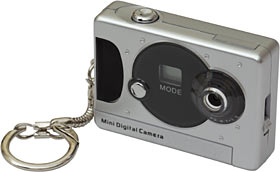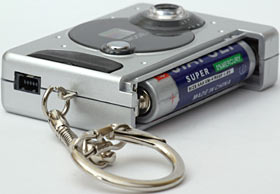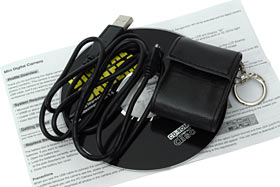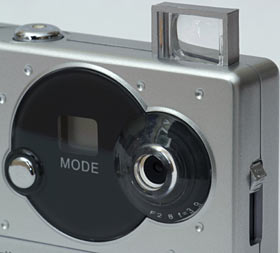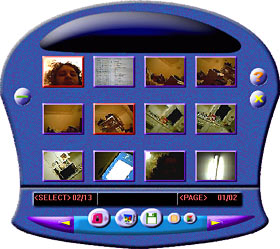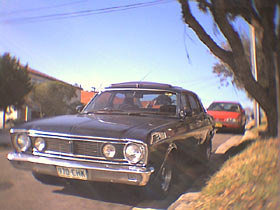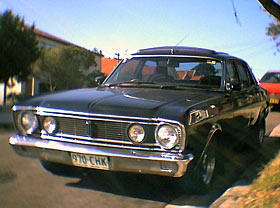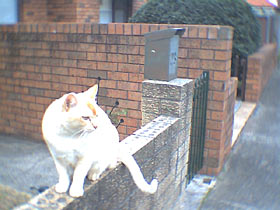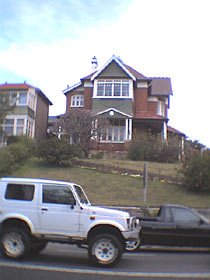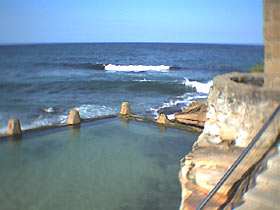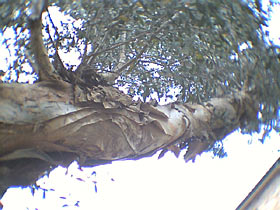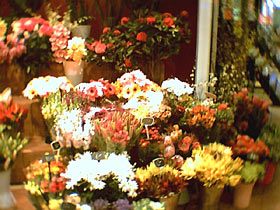
Quick Shot review 1:
GTW Electronics keyring digital camera
Review date: 10 September 2003.
Last modified
03-Dec-2011.
As I've mentioned on previous occasions, I've got a lot of time for cheap little "toy" digital cameras.
Sure, they lack a lot of the useful features of their more expensive brethren (no zoom, usually no focus adjustment, seldom an LCD screen...) but they're simple, they're cheap, they're small, and they're fun. And they do, within the definition of the term, take pictures.
Yes, it'd be nice if they had better lenses. But never mind the quality, feel the price.
The toy-cam market has expanded considerably with the arrival of mobile phone cameras. While all of those have screens - because they use the phone screen - they're otherwise on par with the other baby-cams. And, clearly, a lot of people are happy with that level of image quality.
Here's a weeny digicam from GTW Electronics. It's a really little baby-cam, as the keyring hanging off the side of it ought to indicate. Not counting the keyring, it's about 59 by 32 by 15mm in size, with a protective bulge around its tiny lens that pushes its depth measurement all the way up to about 18mm. Even with a battery, it only weighs about 33 grams.
What's it cost? $AU60.50 delivered, from Aus PC Market.
[NOTE: This review is old now, and AusPC don't stock this product any more. Identical "keyring cameras" have been all over eBay for years now, though; the going rate seems to be about $US20 including delivery.]
You can pay less for a camera like this, maybe even from the spammers who try to sell them. Aus PC Market's price includes Australian delivery, a warranty, and the knowledge that you're not supporting people who eat adorable kittens, though. As with some other such things, it's not baby-cams' fault that some of them are sold by scum.
Among the forest of variously reputable baby-cam dealers are lots of people selling the same thing under different names. Aiptek is probably the biggest name in baby-cams, but I've no idea who actually makes their cameras. GTW's SY-2102 camera (on this GTW page along with several others) seems to be the same thing as the old Aiptek VGA PenCam. Maybe GTW make the things; I don't know.
On the above-linked GTW camera page, there's the SY-2107, which looks like the camera I got for review. It's not the same, though; the 2107 is only a 320 by 240 camera, while the one I got for review manages a full 640 by 480. Those wise in the ways of baby-cams will know that there isn't necessarily much actual difference there. Lousy lenses mean these things often don't capture much more real image detail than 320 by 240 can convey.
I can't tell you exactly what the model number of this camera is; it's not on the GTW site, and there's no ID on the packaging.
If you've seen baby-cams before, though, this one's feature set will seem pretty familiar.
Unlike older baby-cams, it runs from only one AAA cell. Yes, the battery's included.
The camera's got a mini-USB port for PC connectivity; the cable's included as well.
In fact, you get a pretty good bundle with the thing.
The software CD contains drivers for the camera in both still and webcam mode (you don't have to do anything to the camera to tell it to be one or the other; it's switched from the PC), plus Arcsoft Photo Impression 4.0 and Videoimpression 1.6 (are they any good? For the money, yes!).
And there's a simple but adequate fold-out manual, replete with unusually polite almost-English ("Use the viewfinder to find the things for which you desire to take photos"; "during the continuous shooting period, the incorrect exposure will possibly appear due to the shortage of rays").
And, yes, a dainty little soft case for the camera, with a belt loop on the back. It takes a deft touch to close the hook-and-loop flap without pressing a button on the camera, but it's still neat.
Features
The camera's got a normal suite of baby-cam features. Two control buttons, and a two-character LCD display, unusually located on the front of the case; the back panel has nothing on it at all. The LCD displays cryptic codes to tell you what you're doing, and the edges of the display are hard up against the edges of the hole it's mounted in, but there are few enough features that it's not a nightmare to use.
The camera powers off automatically after 30 seconds of inactivity; you can also press the Mode button once and then the shutter button to turn it off immediately. Battery life won't be as good as you might hope, because this camera is of the old, non-flash-RAM type. This means its eight megabytes of internal memory (enough for 26 640 by 480, minimum compression pictures) is kept alive by the battery.
In use, the camera draws a relatively hefty 120mA or so when just sitting there, and peaks at about 190mA when taking a picture. The battery it comes with is a carbon-zinc (non-alkaline) cell, which doesn't like this much load at all; the display was flashing (that's the low-battery warning) after I'd taken only 40 or so shots, and left the camera overnight with images in its memory.
The overnight stay matters, because the non-Flash memory means the more pics the camera's holding, the more it'll be draining its AAA cell when it's "off". With nothing in the memory it draws about half a milliamp when it's off; with the memory full it draws about 2.4mA. Quality alkaline AAA cells have capacity of 1100 milliamp-hours or so into a small load like this, but they'll be knocked down faster by the much higher in-use draw of the camera. Even a near-dead battery ought to be good enough to preserve the memory contents, though.
All this means that you should take the battery out when you're not using the camera. You can power it from the USB lead when it's got no battery, by the way.
Back to the feature list. There's a ten second self-timer, a continuous 320 by 240 mode that shoots frames fast enough to be useful as a (silent) movie mode, and two quality modes to go with the two resolutions.
Oh, yes. There's a viewfinder, too.
Ain't that cute? A little slider on the side pops it into view.
This is a long range viewfinder; put your eye to it and you'll just get a blur, but view it from at least a few inches away and you'll see an extremely miniaturised version of what's in front of the camera. If you're lined up right with the back of the camera then the viewfinder will help you frame your shot; if you're not, it won't. There's a knack to it, which I didn't quite develop during my testing.
Baby-cams like this one with tiny little pinprick lenses aren't for people who do a lot of arty arrangements with major picture elements around the edge of the frame anyway. This is because these lenses only give reasonably sharp results in the middle of the frame. The further away something is from the camera, the more distorted it'll be if it falls close to the edge of the frame. As you'll see shortly.
Software
The important software for baby-cams isn't the image and video editing packages they come with. Good, bad, who cares, get The GIMP or Virtual Dub for free if you need something better. The driver software is what matters.
Proper digital cameras these days come with driver software that makes them look like a removable drive to the computer. Actually, Windows and Mac users with recent OS versions often don't need to install a driver at all, thanks to USB Mass Storage Class drivers built into the OS.
Baby-cams don't work that way, but at least this one has...
...this. It looks dumb, because apparently baby-cam software interfaces all have to, but it works well enough. It's quite easy to perform Basic Function 1, selecting every image on the camera and dumping them all to a disk directory.
The software works on Windows 98SE, ME, 2000 and XP, and lets you save images as JPGs or BMPs. The JPEG compression is obviously being done by the software, not the camera, and isn't as efficient as it might be - 640 by 480 pics average out at about 100 kilobytes in size, and I found saving the BMPs to JPEG in other software could reduce that by about a third to a half with no visible quality loss. But it'll do; the JPEGs as they stand are pretty much pixel-identical to the BMPs.
(You can, of course, forget about getting any EXIF data in the JPEGs.)
There's a webcam driver program too, and the camera should work as a regular Windows Video source for whatever software you care to use with it. If you want sound, you'll need to plug a separate microphone into your PC, though.
Photos
I thought I'd lined this car up in the middle of the frame, but my inexperience with the viewfinder betrayed me. As a result, it fell uncomfortably close to the left edge and got itself blurred, by the characteristic circular "bottom-of-a-glass" distortion that tiny cheap lenses like this always have.
Note also the interesting flare lines pointing towards the sun, out beyond the top left corner of the frame. The transparent lens surround introduces some flare effects I've not previously seen.
This image also has a problem that all bright-sunny-day pics taken with this camera seem to have - it's somewhat over-exposed, and makes no use of about the bottom quarter of the available intensity values.
After a quick Photoshop crop and tweak, I had this. Not too bad in the thumbnail view; less exciting full sized. All of the shots are like this. This is what I mean when I say that 640 by 480 baby-cams with really ordinary lenses, like this one, really might as well be 320 by 240. At that size or smaller, the pictures look better.
Another example of poor exposure. This cat is actually ginger all over.
Woo, arty portrait-aspect-ratio shot. This one illustrates another problem of cheap lenses:
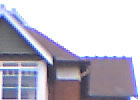
Chromatic aberration.
Good lenses don't have fat blue fringes on dark-to-light transitions.
Everybody photographs this darn place.
See how the right side of this picture of a paperbark tree is much fuzzier than the left? That's because the branch is further away on the right. Note also another big fat dose of chromatic aberration.
Ah, the shopping centre florist. Saviour of the quick and dirty camera reviewer looking for a super-colourful subject.
This is an indoor picture, with a much lower light level than the outside shots, so the camera did a better job of the exposure. It's still "blown out" some pale flowers into solid white, but it's not too foul a result.
For regular household night-time indoor photography, this little camera's better than many tiny-cams I've seen. It's got higher noise and funny vertical sensor lines, but they're not terrible, and the closer subject distances of indoor shots reduce distortion effects.
Like the Aiptek baby-cams, though, this one just plumb refuses to take a shot if it doesn't think there's enough light. In a normally lit night-time room, that means you're not likely to be able to photograph anything that isn't quite pale. Ordinary pictures of people will be hard to take, unless they're near a light. I think this camera may be less fussy about lighting than the PenCams were, but I don't have a PenCam handy to compare.
Overall
It's cheap, it's cute, it's a camera. If you've only got $AU60-odd to spend on a digicam, you're not going to get anything much better than this, and its truly tiny dimensions and minimal replacement cost are real advantages. If you want a fun little camera that takes up pretty much no space at all, this thing may suit you just fine.
If you want a real camera for a low price, and don't mind getting something rather larger, then I strongly recommend you save up a bit more money and start trolling for old second hand digitals on the auction site of your choice. Between the tons of dealers selling new baby-cams like this one, you'll find proper big-brand cameras with one to two megapixel resolution (versus 0.3 megapixels for a 640 by 480 camera...) selling for $AU100 to $AU200.
Needless to say, a used $AU150 1280 by 960 camera in decent condition will beat the pants off the little GTW Electronics object.
Cheap baby-cams aren't actually competing with anything that's got an LCD screen and expandable memory and autofocus, though. They've got a category all to themselves, and it's a good category, provided you know what you're buying. If your Geek-O-Phone lacks a camera, this one will fill the gap perfectly.
Aus PC Market no longer sell this camera. Identical cameras are easy to find on eBay and other online flea markets, though.
